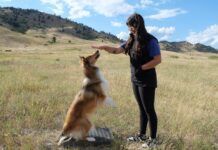Dogs pant for several reasons, the main one being to cool themselves. Dogs can’t perspire the way humans do, though they do have sweat glands in their ears and paw pads. Panting, however, is their major cooling mechanism. When they are hot, rapid breathing releases heat and water from the moist surfaces of their lungs, tongue, and mouth. The cycle of inhaling and exhaling increases the evaporation of water from the respiratory system, which cools them from the inside out. This is normal panting, however excessive panting in dogs can indicate a health issue that needs to be investigated.
Running, jumping, chasing balls, and playing hard will cause a healthy dog to pant, and that’s normal. So will taking a slow walk on a hot day! Deep, fast, heavy breaths are familiar signs of heat dispersal, and they correlate with the dog’s activity level and the ambient air temperature.
That said, there are a few other conditions that can also make a dog pant:
- Excitement. Rapid, shallow breathing is a typical response when dogs are aroused and interested in what’s happening now, such as when seeing other dogs, meeting new people, or anticipating the delivery of food or a treat.
- Stress. Dogs pant when they experience anxiety, worry, nervousness, or fear. Stress signals include yawning, whining, wide eyes, dilated pupils, lip licking, drooling, a crouched posture, looking away, or other signs of discomfort.
- Medication. Some prescription drugs, such as prednisone and other steroids, can cause side effects of heavy breathing or panting.
How to calm a panting dog
Dogs take between 10 and 30 breaths per minute, depending on their size and physical condition. Study your dog’s breathing patterns so you can recognize changes that require attention. In general:
- Keep water handy. Panting results in the evaporation of water from the dog’s body, which can cause dehydration, so provide a constant supply of clean water whenever your dog is playing, running hard, or just out for a stroll if the weather is hot.
- Change your dog’s mindset (and perhaps location). If your dog is panting more from stress than excitement, move to a more comfortable location and find ways to prevent your dog’s stress from escalating. Attention training is helpful here: Practice saying your dog’s name and rewarding her for looking at you or coming when called. Practicing and rewarding familiar behaviors can help shift your dog’s focus away from whatever is causing stress and excessive panting.
- Pharmaceutical help. Noise phobias are a type of stress that often worsens as a dog ages. Noise phobias can be treated pharmaceutically on an as-needed basis, such as for fireworks and thunder, or with longer-acting anxiety products. These treatments are best used before phobias develop into a major problem; talk to your veterinarian. See “Medications for Anxiety,” WDJ March 2022.
Medical emergencies: When to call a vet about your dog’s panting
Call a veterinarian immediately if you notice any of the following symptoms:
- Your dog’s breathing changes suddenly, the panting is constant and intense, and/or the dog’s breathing sounds raspier, louder, or harsher than normal.
- Your panting dog loses his balance, becomes weak or uncoordinated, collapses, drools excessively, has a bright red tongue, and seems disoriented. These are all signs of dangerous heat stress.
- Your dog’s temperature is above 104ºF. If possible, test with a rectal thermometer.
- Your dog’s tongue or gums appear blue, purple, or white. These are signs that he isn’t getting enough oxygen.
- Your dog is a nursing mother. Deep, intense, heavy panting may be a symptom of eclampsia, also called milk fever, which is a dangerous condition caused by a drop in blood calcium levels.
Panting and other health problems
Panting can be a symptom of other problems that may require attention even though they aren’t medical emergencies. Be familiar with your panting dog’s symptoms so you can discuss them with your veterinarian.

Physical discomfort, nausea, and other physical symptoms can trigger panting, which is often the first pain symptom to manifest, occurring before more obvious pain indicators, such as whining or limping.
Laryngeal paralysis is the result of a vocal cord dysfunction. Coughing, especially after exercise or exertion, is the most frequently reported symptom, followed by noisy breathing, exercise intolerance, excessive panting, and a change in the sound of the dog’s bark (dysphonia).
Some chronic diseases cause excessive panting, such as heart failure, which contributes to breathing difficulties, reduced exercise tolerance, and coughing. Cushing’s syndrome, which occurs when a dog’s adrenal glands produce too much cortisol, can also cause excessive panting. So can respiratory disorders such as pneumonia and lung tumors. Follow your veterinarian’s advice regarding exercise and other activities if your dog has a chronic illness.
Overheated dogs become dehydrated, restless, and unresponsive as they attempt to cool themselves by panting. Heat stroke symptoms can include drooling, vomiting, diarrhea, a racing heart, and physical collapse. Overweight or obese dogs, long-haired dogs, dogs with dark or heavy coats, brachycephalic breeds, and dogs with laryngeal paralysis are at a higher than average risk of heat stroke.
Brachycephalic (short-nosed or flat-faced) dogs such as Pugs, Boston Terriers, Boxers, French Bulldogs, and English Bulldogs have narrow nostrils and smaller airways than other dogs, and this predisposes them to heatstroke because they cannot pant sufficiently to cool themselves. They often make abnormal snorting sounds while panting because of a long soft palate or excessive tissue in the throat that obstructs the airway. It’s even more important to keep these dogs cool and listen for changes in their panting and breathing patterns.
If you think your dog is overheating, don’t just offer water to drink. If a tub or stream is available, you can submerge your dog in cool (not cold) water. Applying cool, wet towels to his chest, neck, head, groin, and feet, and continually replacing or re-wetting the towels (because they warm up quickly) is the next-best method of cooling him. Pouring water over his body using a watering can or bowl isn’t much help; it won’t get the cooling water on his skin (especially on his groin and tummy). You can use an outdoor hose, but check to make sure the water’s temperature is cool, rather than hot from sun exposure or uncomfortably cold. Keep your dog in the shade and out of direct sunlight; if you’re indoors or in your car, run the air conditioner, and/or use a portable battery-powered fan to increase airflow.
Heat stroke can be fatal. If your dog shows any symptoms of heat stroke, contact your vet or emergency clinic at once. For more information, see “Avoiding Heat Stroke in Dogs,” July 2019.
Abnormal panting deserves attention!
Even if everything else about your dog appears to be normal, call your veterinarian if you observe abnormal panting whose causes you can’t explain. The early diagnosis of underlying conditions that contribute to excessive panting improves the odds of successful treatment.






